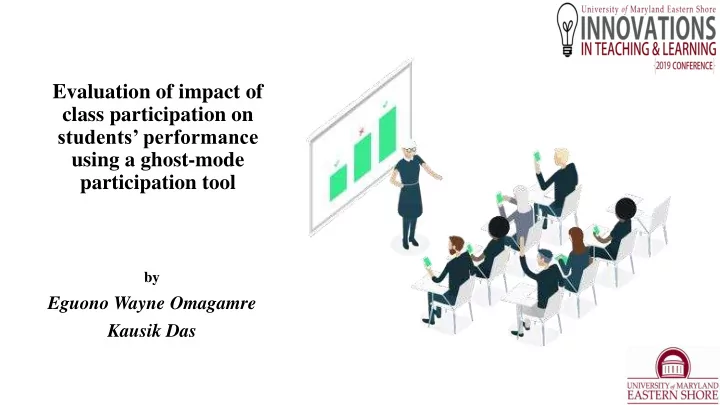

Evaluation of impact of class participation on students’ performance using a ghost-mode participation tool by Eguono Wayne Omagamre Kausik Das
Outline of Presentation • 1.0 Introduction • Value of STEM Education • Challenges with Higher Ed. STEM Pedagogy • Class participation in Higher Ed. pedagogy • Aim of Study • 2.0 Methodology • Study Design • Mentimeter Presenter tool • Designing presentations on Mentimeter • Sample Class Presentation • Data analysis • 3.0 Results • Class grade distribution • Assessment of significance impact of Mentimeter on Students’ Lab scores • Assessment of the linear relationship between Class participation and Class Average Scores • Impact of Lab Experiment Sequence on Class Average Score • 4.0 Conclusion • 5.0 Future Direction • 6.0 References 2
1.0: Introduction 3
1.1: Value of STEM Education • Between 2017 and 2027 STEM jobs are projected to grow by 13% against a 9% projected growth in non-STEM related fields • In the US between 2014-2017, the unemployment rates for STEM and non-STEM fields were 2.2 and 5.5% respectively • The US Bureau of Statistics reported a annual salaries of STEM and non-STEM jobs to be $87,570 and $45,700 respectively https://www.ipwatchdog.com/2018/01/22/google-downplays-stem-education/id=92590/ 4
1.2: Challenges with Higher Ed. STEM Pedagogy • Loss of Students’ interest • tight academic schedules and stress • The disconnection between research and practice • Lack of connections with complex theoretical concepts may lead to disenchantments 5
1.3: Class participation in Higher Ed. pedagogy • Active involvement of students in classroom settings improves their understanding of the course materials being learned (Ramsden, 2003) • A number of factors however may impede participation: • Fear of embarrassment • Lack of content knowledge https://www.svjhscounseling.com/social-anxiety.html 6
1.4: Aim of Study • Evaluation of the relationship between class participation and performance using Mentimeter instructive technology 7
2.0: Methodology 8
2.1 : Study Description • This study was carried out within the Spring 2019 semester • All the students in the Physics 184H lab served as the cohorts of this study • Mentimeter presentations with opportunities for participation were used for 5 of 8 pre-Lab sessions 9
2.2: Mentimeter Presenter tool 10
2.3: Designing Presentations on Mentimeter 11
2.4: Designing Presentations on Mentimeter 12
2.5: Sample Class Presentation 13
2.3: Data analysis • A Box plot was used to visualize the class grade distribution • Assessment of impact of Mentimeter on Students’ Lab scores was carried out using the Welch’s T -test • Pearson’s Correlation Coefficient was used to assess the linear relationship between Class participation and Class Average Scores • Impact of Lab experiment sequence on class average score was also evaluated in comparison to the impact of Mentimeter 14
3.0: Results 15
3.1: Student’s Grade Distribution 16
3.2: Assessing the significance of the impact of Mentimeter on Students’ Lab scores Without Mentimeter With Mentimeter Mean 80.6 84.8 Variance 144.3 90.9 Observations 70 116 Hypothesized Mean Difference 0 t Stat -2.52 P(T<=t) one-tail 0.007 t Critical one-tail 1.66 P(T<=t) two-tail 0.013 t Critical two-tail 1.978 17
3.3: Assessment of the linear relationship between Class participation and Class Average Scores 100 95 Pearson’s correlation coefficient (r) = 0.924 Class Average Score (%) 90 85 80 75 70 65 60 55 50 0 10 20 30 40 50 60 70 80 90 100 Class Participation (%) 18
3.4: Impact of Lab Experiment Sequence on Class Average Score 95 90 Class Average Score (%) r = 0.607 r = 0.381 r = 0.675 Lab 1 Lab 2 85 Lab 3 Lab 4 80 Lab 5 Lab 6 Lab 7 75 Lab 8 70 65 PHY 1 PHY 2 PHY 3 Sequential Lab sessions for different classes 19
4.0: Conclusion • Obtained data suggests that the use of Mentimeter improved class grades in a statistically significant manner (95% confidence interval) • The observed improvements in class average score correlated positively with class participation • Lab sequence had a lesser impact on class average score in sessions that used Mentimeter compared to those that did not use it • Student’s were very excited to participate in the class modules using the Mentimeter tool 20
4.0: Conclusion Word Cloud showing students’ comments on one of the lab presentation using Mentimeter 21
5.0: Future Direction • Practical and real life scenarios would be designed into lab presentations to improve students’ engagement with theoretical concepts • Incorporation of concept-cartoon based physics questions into lab modules for pre-lab consideration 22
6.0: References • Education Commission of the States (2017): “STEM Demand”. Retrieved from vitalsigns.ecs.org/state/united-states/demand • Lee, A (2018): Disconnections Between Research and Practice in STEM Education. Higher Education Today. Retrieved from http://www.higheredtoday.org/2018/06/13/disconnections-research-practice-stem- education/ on May 28, 2019 • Rhodes, S (2017): Challenges to STEM Education and How to overcome Them. College Planning and Management. Retrieved from http://webcpm.com/articles/2017/05/18/stem-education.aspx?m=2 on May 28 • Ramsden P (2003): Learning to teach in higher education. RoutledgeFalmer. Taylor and Francis Group 23
24
Recommend
More recommend